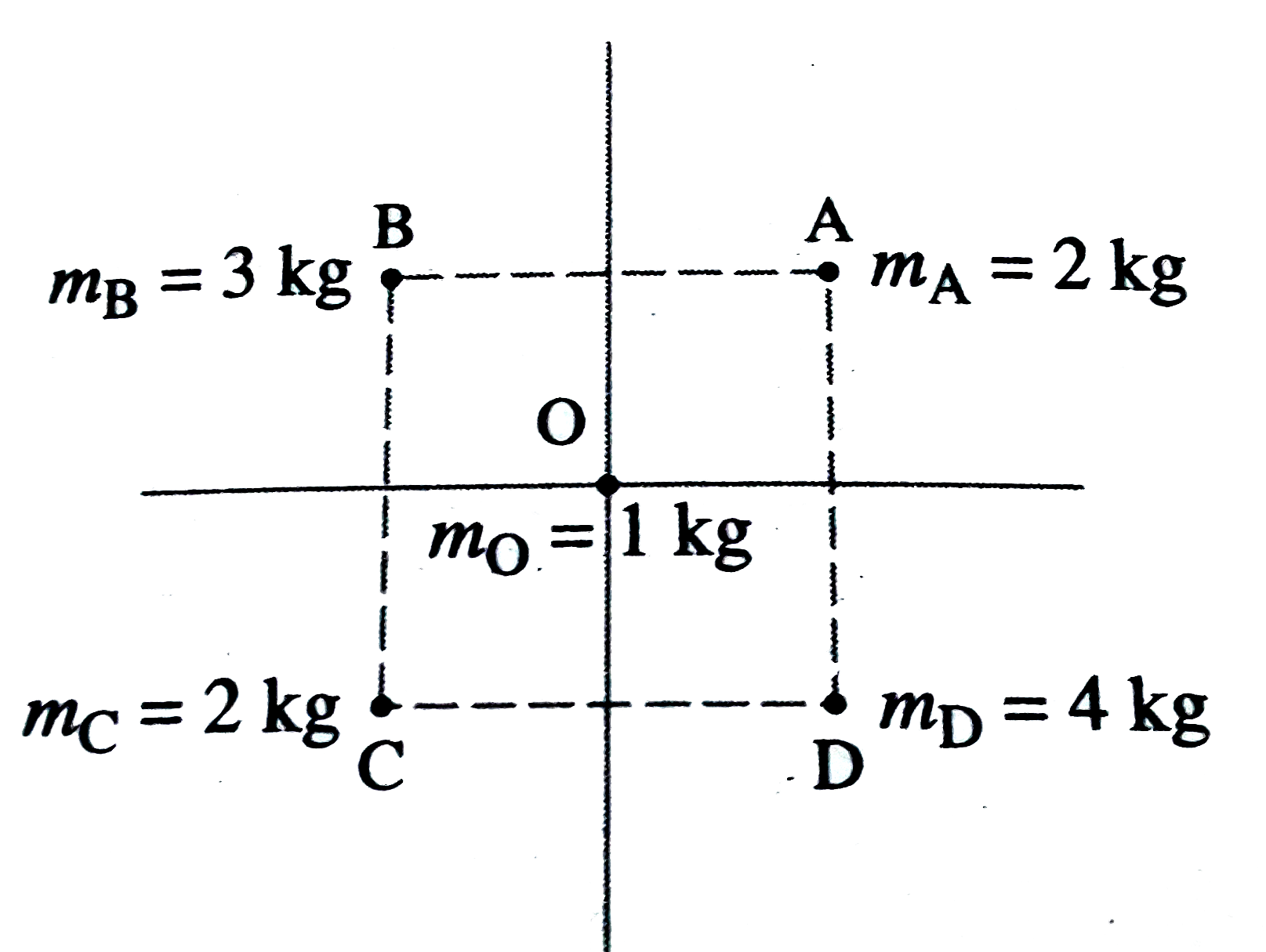Four particles having masses, m, wm, 3m, and 4m are placed at the four corners of a square of edge a. Find the gravitational force acting on a particle of mass m placed at the centre.
The correct Answer is:A, B, D
To find the gravitational force acting on a particle of mass m placed at the center of a square with four particles at its corners, we can follow these steps:
1. Identify the Setup:
We have a square with side length a. The masses at the corners are m, 2m, 3m, and 4m. The mass m is placed at the center of the square.
2. Calculate the Distance from the Center to the Corners:
The distance R from the center of the square to any corner is given by:
R=a√2
3. Calculate the Gravitational Force from Each Mass:
The gravitational force F between two masses m1 and m2 separated by a distance r is given by:
F=Gm1m2r2
For each corner mass, we can calculate the force acting on the mass m at the center.
- Force due to mass m at corner:
F1=Gm⋅mR2=Gm2(a√2)2=2Gm2a2
- Force due to mass 2m at corner:
F2=G(2m)⋅mR2=G⋅2m2(a√2)2=4Gm2a2
- Force due to mass 3m at corner:
F3=G(3m)⋅mR2=G⋅3m2(a√2)2=6Gm2a2
- Force due to mass 4m at corner:
F4=G(4m)⋅mR2=G⋅4m2(a√2)2=8Gm2a2
4. Determine the Resultant Forces:
The forces F1 and F3 act in opposite directions along one diagonal, and F2 and F4 act along the other diagonal. Since they are symmetrical, we can calculate the net force in one direction and then combine them.
- Net force along one diagonal:
Fnet, diagonal 1=F4−F2=8Gm2a2−4Gm2a2=4Gm2a2
- Net force along the other diagonal:
Fnet, diagonal 2=F3−F1=6Gm2a2−2Gm2a2=4Gm2a2
5. Calculate the Resultant Force:
Since both net forces are equal and act at right angles to each other, we can use the Pythagorean theorem to find the resultant force Fnet:
Fnet=√(Fnet, diagonal 1)2+(Fnet, diagonal 2)2=√(4Gm2a2)2+(4Gm2a2)2
=√2(4Gm2a2)2=4Gm2a2√2
6. Final Result:
Thus, the gravitational force acting on the particle of mass m at the center is:
Fnet=4√2Gm2a2
We have a square with side length a. The masses at the corners are m, 2m, 3m, and 4m. The mass m is placed at the center of the square.
The distance R from the center of the square to any corner is given by:
R=a√2
The gravitational force F between two masses m1 and m2 separated by a distance r is given by:
F=Gm1m2r2
For each corner mass, we can calculate the force acting on the mass m at the center.
F1=Gm⋅mR2=Gm2(a√2)2=2Gm2a2
F2=G(2m)⋅mR2=G⋅2m2(a√2)2=4Gm2a2
F3=G(3m)⋅mR2=G⋅3m2(a√2)2=6Gm2a2
F4=G(4m)⋅mR2=G⋅4m2(a√2)2=8Gm2a2
The forces F1 and F3 act in opposite directions along one diagonal, and F2 and F4 act along the other diagonal. Since they are symmetrical, we can calculate the net force in one direction and then combine them.
Fnet, diagonal 1=F4−F2=8Gm2a2−4Gm2a2=4Gm2a2
Fnet, diagonal 2=F3−F1=6Gm2a2−2Gm2a2=4Gm2a2
Since both net forces are equal and act at right angles to each other, we can use the Pythagorean theorem to find the resultant force Fnet:
Fnet=√(Fnet, diagonal 1)2+(Fnet, diagonal 2)2=√(4Gm2a2)2+(4Gm2a2)2
=√2(4Gm2a2)2=4Gm2a2√2
Thus, the gravitational force acting on the particle of mass m at the center is:
Fnet=4√2Gm2a2
Topper's Solved these Questions
Similar Questions
Four particles of masses m, m, 2m and 2m are placed at the four corners of square of side a. Find the centre of mass of the system.
View SolutionIf four different masses m1,m2,m3 and m4 are placed at the four corners of a square of side a, the resultant gravitational force on a mass m kept at the centre is
View Solution
Knowledge Check
Four bodies of masses 2, 3, 5 and 8 kg are placed at the four corners of a square of side 2 m. The position of CM will be -
A(89,139)B(79,119)C(119,139)D(119,89)Four particles of masses 1kg, 2kg, 3kg and 4kg are placed at the four vertices A, B, C and D of a square of side 1m. Find the position of centre of mass of the particles.
A(0.5,0.3)B(0.4,0.3)C(0.5,0.8)D(0.7,0.3)
Four particles of masses 2 kg, 3 kg, 2 kg and 4 kg are at the corners of a square of diagonal 4 m, as shown. The net gravitational force on a particle of mass 1 kg at the centre of the square is [Take G=203×10−11 SI units, pN≡piconewton]

View SolutionFour particles of masses m, m, 2m and 2m are placed at the corners of a square of side a, as shown in fig. Locate the centre of mass.
View SolutionFour particles of masses m,2m,3m,4m are placed at corners of a square of side 'a' as shown in fig. Find out coordinateds of centre of mass.

View SolutionThe four particles of masses m,3m,2m and 4m are placed on the vertices of a sqare of side L. Locate the center of mass

View SolutionFour particles of masses 1 kg, 2 kg, 3 kg, 4 kg are placed at the corners of a square of side 2 m. Find the coordinates of centre of mass.
View SolutionFour masses, each equal to M are placed at the four corners of a square of side a. Calculate the force of attraction on another mass m, kept at the centre of the square.
View Solution
